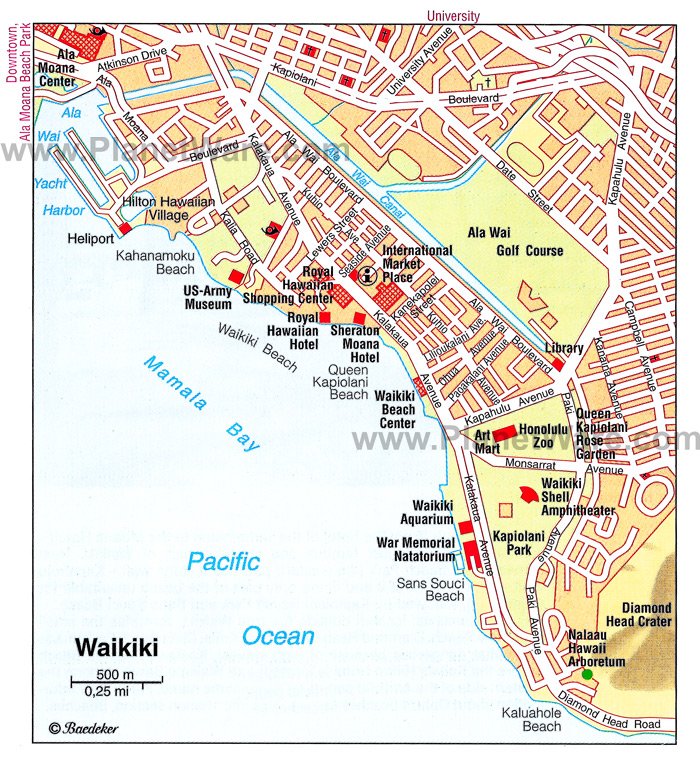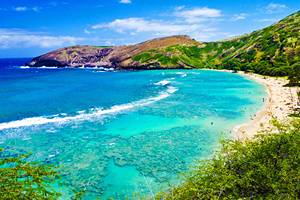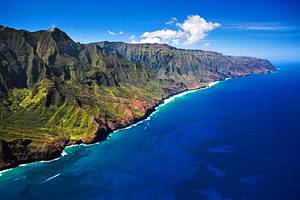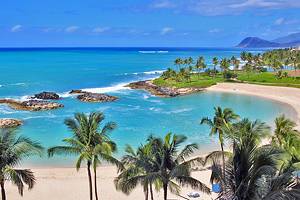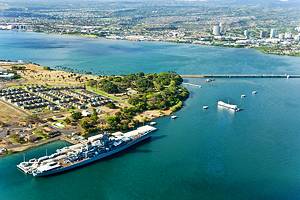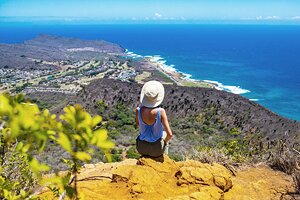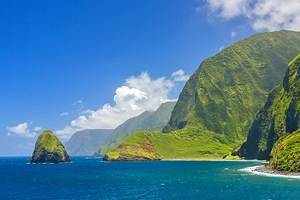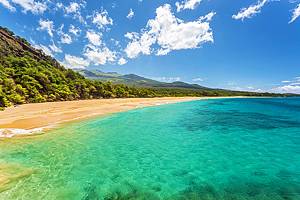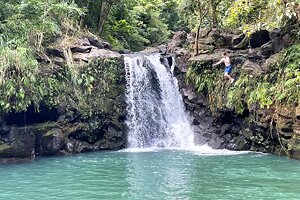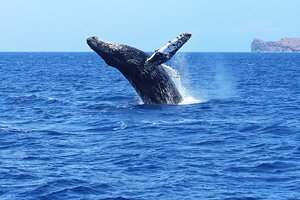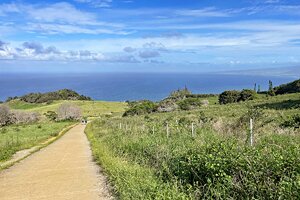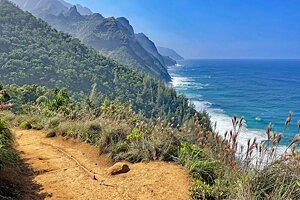Tourist Attractions & Things to Do in Waikiki
Waikiki is perhaps one of the most famous beach resort destinations in the world. The sun-bleached, beachy stretch of Honolulu overlooks the South Sea and is the most popular place in Hawaii for tourists. Sandwiched between downtown Honolulu and Diamond Head Crater, Waikiki is truly the heart of Honolulu and Hawaii in general.
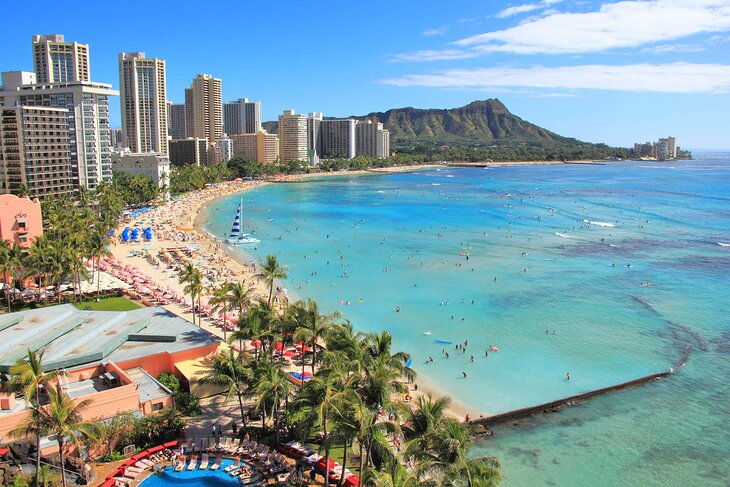
The highest concentration of hotels on the Hawaiian islands can be found right here in Waikiki. You'll find them either along the beach or along Kalakaua Avenue, the main artery in Waikiki. The streets that offshoot Kalakaua Avenue are jam-packed with restaurants, shopping, entertainment, and things to do.
Waikiki is, without a doubt, the most beautiful part of Honolulu. If you like high-end beach vibes and a hotbed of energy and activity, Waikiki should be the first place to visit in Oahu, or Hawaii in general.
Plan your sightseeing adventures with our list of the top attractions and things to do in Waikiki.
- Visit Waikiki Beaches
- Diamond Head Crater
- Atlantis Submarines
- Waikiki Aquarium
- Honolulu Zoo
- Kapiolani Park and Queen Kapiolani Garden
- Go Snorkeling: Explore the Reefs
- Go Surfing on Waikiki Beach
- Glass-Bottom Boat Cruises
- Kalakaua Avenue
- International Market Place
- Royal Hawaiian Shopping Center
- US Army Museum of Hawaii
- Shangri La
- See the Kūhiō Beach Hula Show
- Visit Iolani Palace
- Map of Tourist Attractions & Things to Do in Waikiki
Visit Waikiki Beaches
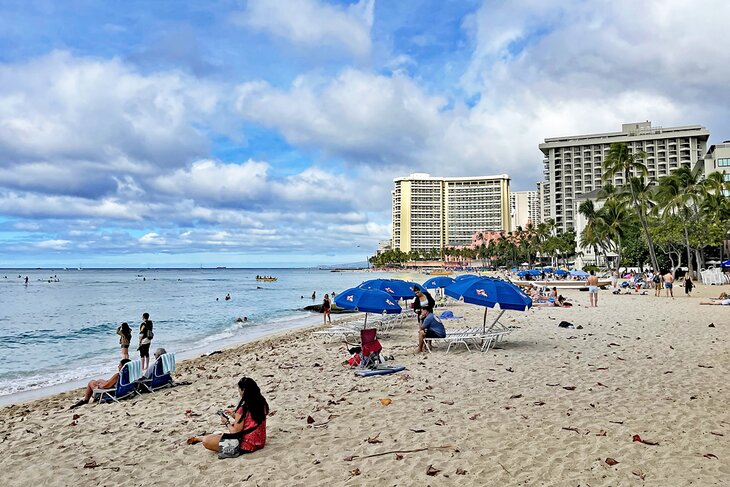
The main attraction of Waikiki, by far, is the two-mile sand strip along the oceanfront. Waikiki has a series of beaches, almost all of which are ideal for swimming and water sports, including snorkeling, boogie-boarding, canoeing, and, of course, surfing.
The beaches begin in the west with Duke Kahanamoku Beach, named after the famous Olympic swimmer, sitting immediately in front of the Hilton Hawaiian Village. The stretch of sand extends to the east to Sans Souci Beach at Diamond Head. Beaches overlap one another so smoothly that tourists find them indistinguishable.
Just past Kahanamoku Beach is Fort DeRussy Beach Park, a lovely spot that offers a grassy area for picnics and recreation. This is followed by the small Gray's Beach and then the Royal Hawaiian Beach, which is without a doubt the most famous and crowded part of Waikiki. Beachgoers will find most of the area's amenities centered around this area, including catamaran rentals, outrigger canoes, and surfing lessons, as well as several beach shacks.
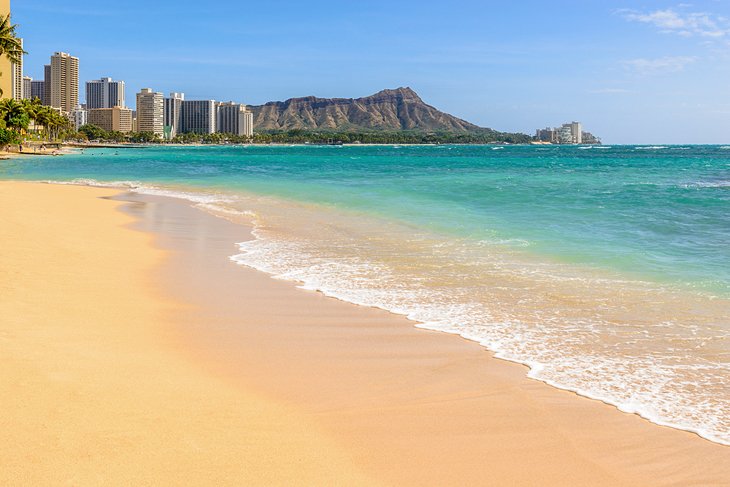
Next comes Kuhio Beach Park, also known as Prince Kuhio Beach or "The Ponds," a nickname that was the result of cement wall enclosures. These have created calm swimming areas that are ideal for younger swimmers. Beyond this is Kapiolani Beach Park and Sans Souci Beach.
Additional beaches, located outside of Waikiki proper, include the small Kaluahole Beach; Diamond Head Beach Park; Kuilei Cliffs Beach Park, made somewhat dangerous because of high waves; Kaalawai; Kahala Beach, where The Kahala Hotel & Resort is located; and Wailupe Beach Park, on the western side of the artificial peninsula of the same name.
- Read More: Beaches in the Honolulu Area
Diamond Head Crater
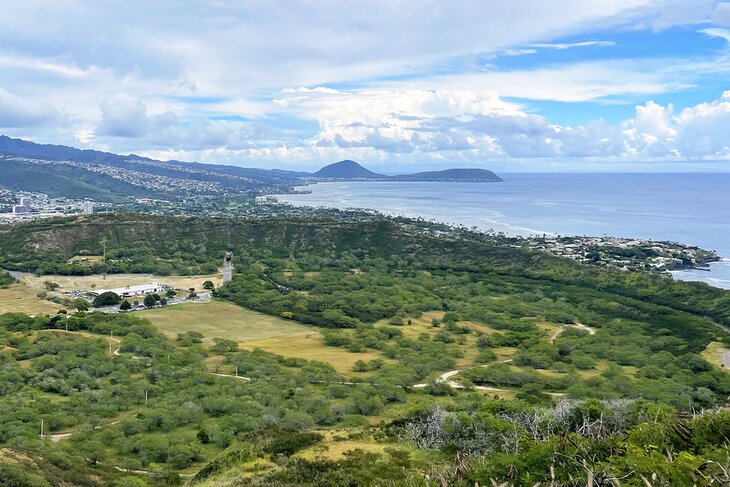
Waikiki is close to some of the best hiking in Oahu, but perhaps the most iconic hiking trail in Waikiki is the hike up Diamond Head Crater. Diamond Head Crater, also known as Le'ahi in Hawaiian, is the now-extinct volcano to the east of Waikiki and is one of the symbols of Oahu and Honolulu.
The magnificent piece of land is absolutely gorgeous to look at. It was named Diamond Head in the 19th century when sailors thought the crystals found here were diamonds. They weren't, but the name stuck.
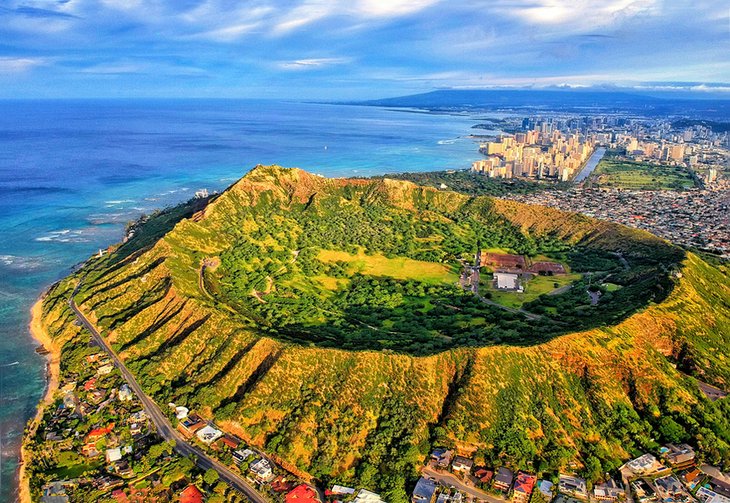
One of the most popular hiking trails in the area is at Diamond Head State Monument. The historic trail at this state landmark rises from the floor of the crater up to the summit along a steep path. The path turns to stairs closer to the summit. At the top, visitors will have one of the most epic views of Waikiki.
Note: If you're an experienced hiker, this is a fairly easy hike. Keep in mind, however, that the trail will be very crowded and can be slow-going, as oftentimes you're walking single file.
Atlantis Submarines
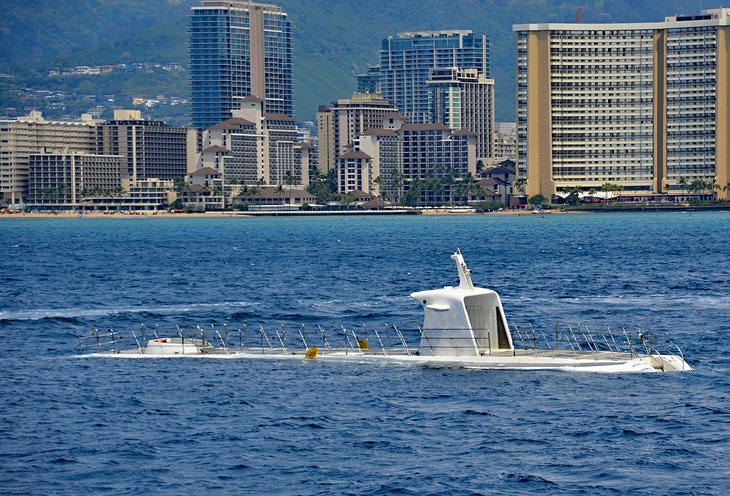
Atlantis Submarines offers tourists the opportunity to stay dry in one of their passenger submarines while taking in the wonders of the undersea world.
While exploring beneath the surface, guides provide fascinating details about the numerous fish and other sea creatures, as well as commentary on the various man-made objects that can be seen offshore. Among these are ships and airplanes that have been sunk intentionally to help create barriers and protective places for the reef and fish to re-grow after destruction by both weather and human activities.
These submarines can be a good option for families or those who are not interested in scuba diving but would still like a truly immersive underwater experience. If you are lucky, a whale might even meander by to inspect the sub.
Address: 252 Paoa Pl, Honolulu, Hawaii
Waikiki Aquarium
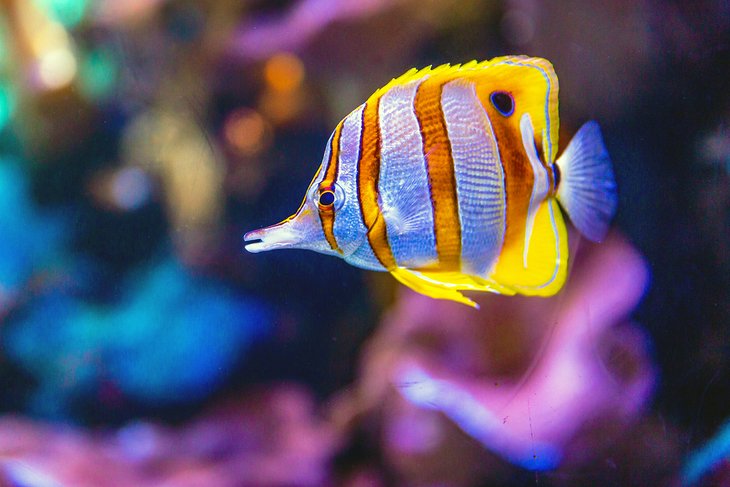
The Waikiki Aquarium educates visitors about Hawaii's unique sea life and the marine communities of the South Pacific. Exhibits feature both habitats and specific animals, with a large portion of the aquarium dedicated to the ecology and residents of coral reefs.
Within several coral reef exhibits, kids will love to learn about the relationship between clownfish and sea anemones; get an up-close look at reef predators like sharks and groupers; and view the aquarium's coral farm, which produces colonies that are used by other aquariums around the world.
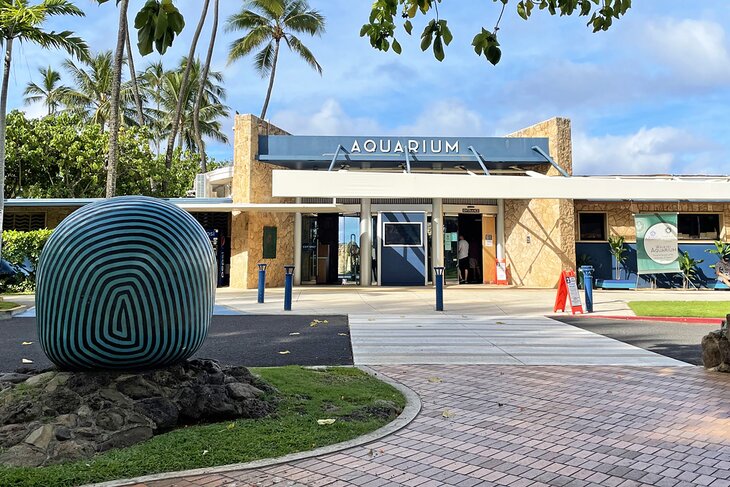
Visitors also come to see the aquarium's Northwestern Hawaiian Islands exhibit, home to two critically endangered monk seals, as well as several other unique marine species only found among these uninhabited islands. Other exhibits include the underwater habitat in a mangrove forest, giant clams, jellyfish, and an assortment of rare deep-sea fish and invertebrates.
Address: 2777 Kalakaua Avenue, Honolulu, Hawaii
Honolulu Zoo
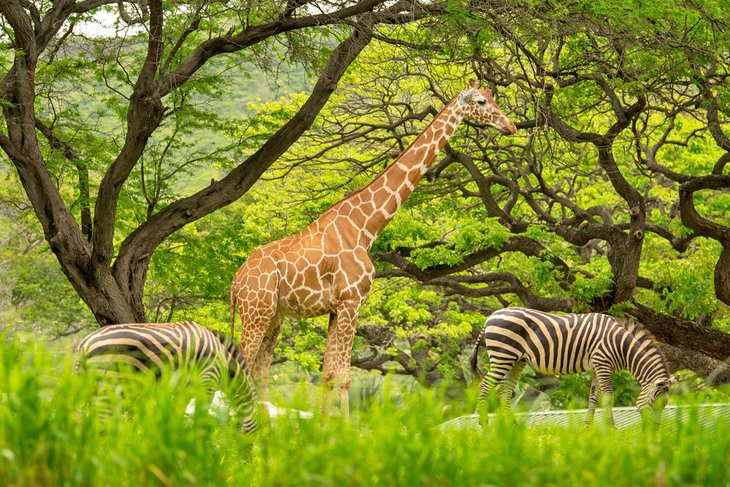
The Honolulu Zoo is a 42-acre zoo featuring hundreds of animals, birds, reptiles, and amphibians. The grounds also include a huge variety of tropical plants, creating a botanical garden setting, which includes native Hawaiian plants. There are also native Hawaiian animals in residence, including the Hawaiian Goose, Nene, and the Hawaiian Hawk, 'Io. Additionally, there are many favorites such as tigers, elephants, monkeys, and Komodo dragons.
The Honolulu Zoo is the only zoo that sits on a royal land grant. Today, the zoo represents three tropical zones: the African Savannah, tropical rainforests, and island ecosystems. There is also a children's zoo and playground.
Address: 151 Kapahulu Avenue, Honolulu, Hawaii
Kapiolani Park and Queen Kapiolani Garden

This beautiful park, which King Kalakaua gave to the city and now bears the name of his wife, divides Waikiki from the small residential area on the southwest side of Diamond Head.
Kapiolani Park is Honolulu's oldest public park and also the best-loved. It contains family attractions, including the Waikiki Zoo and Waikiki Aquarium, but the main highlight for adults is the Queen Kapiolani Garden, which is home to a beautiful assortment of flowering plants. The garden contains plants from Hawaii and other parts of the world, including rare Hawaiian species.
The park is a pleasant recreational area with a large selection of leisure activities available, including tennis courts, picnic areas, and jogging paths. The Queen Kapiolani Bandstand is the finishing point of the Honolulu Marathon held each December.
Address: 3672-, 3698 Paki Ave, Honolulu, Hawaii
Go Snorkeling: Explore the Reefs
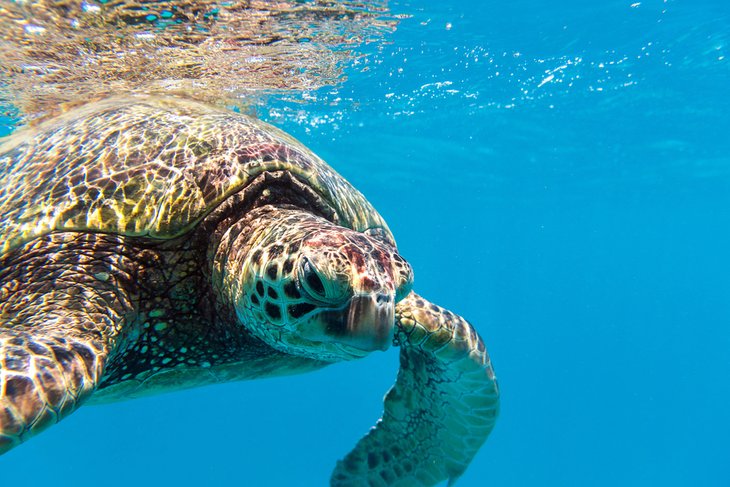
The island of Oahu is home to several top snorkeling spots, one of which is right on Waikiki Beach. The best spot along this long stretch of sand is on the southern end in the Waikiki Marine Conservation District, by the Waikiki Aquarium. The best place to enter the water is at Queen's Beach or the adjacent Kapiolani Park Beach, where the reef is visible from the shore.
Go Surfing on Waikiki Beach
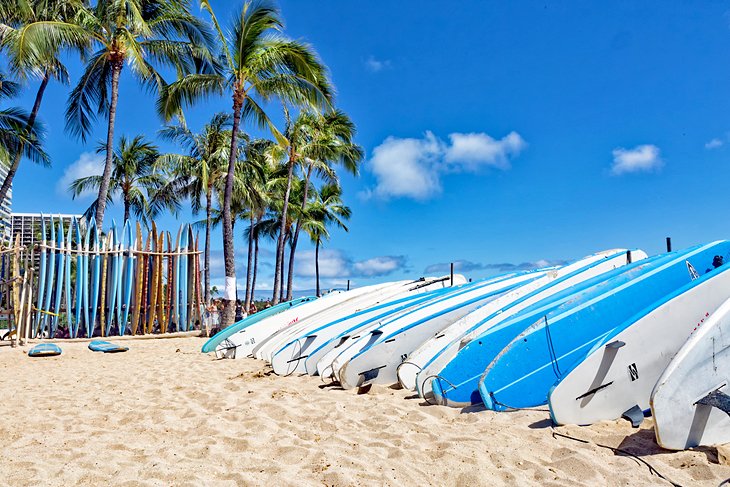
Waikiki was brought into the international spotlight as the surfing mecca by Duke Kahanamoku, Hawaiian surfer, instructor, and Olympic swimmer. The protected bay of Waikiki makes this an ideal place for surfing, especially beginners. It is a must-do for anyone visiting Waikiki, and there are plenty of rental shops along the beach where you can grab a board and hop a wave.
Glass-Bottom Boat Cruises

Tourists who don't want to get in the water or explore the depths by submarine can still enjoy and admire the beauty of the reefs and ocean life off the shore of Waikiki. A glass bottom boat cruise is an accessible excursion that is a great option for those with mobility issues, including wheelchairs.
Glass bottom boats feature a transparent floor for crystal-clear viewing of the colorful fish, sea turtles, and other marine life. Tourists can also spot migrating whales and dolphins from the boat, and get excellent views of Diamond Head Crater and the city of Honolulu. The boat typically includes a shaded area for those who are sensitive to sun, as well as knowledgeable guides.
Kalakaua Avenue
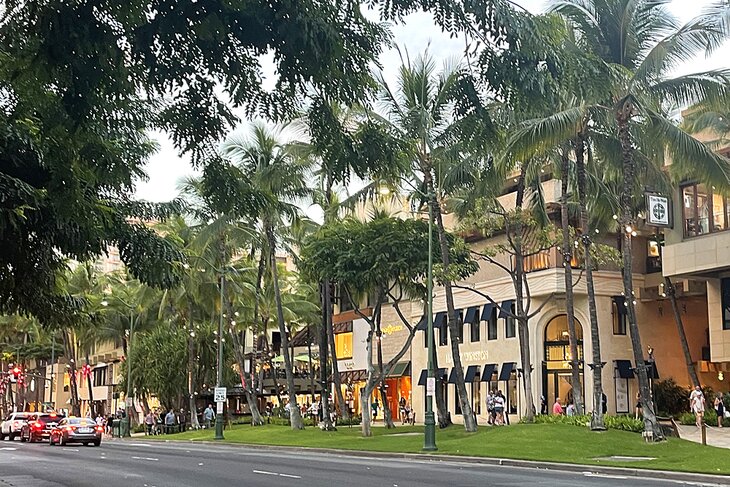
The heart of activity in Waikiki is found along Kalakaua Avenue. The mile-long street runs parallel to the beach from Beretania Street to the end of Kapiolani Park. If you want the highest concentration of hotels, restaurants, and shopping, then Kalakaua Avenue is where it all happens.
What's great about the avenue is that it is within walking distance of the beach but really has a city vibe to it, thanks to the luxury shopping and fabulous restaurants. You'll find the Waikiki Shopping Center, International Market Place, and the Royal Hawaiian Shopping Center all along Kalakaua Avenue.
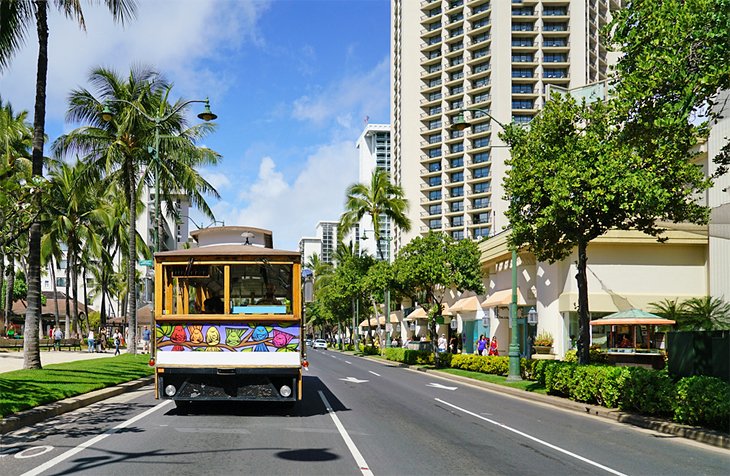
Kalakaua and the streets that branch from it are where the majority of Waikiki's top hotels are. You'll be spoiled for choice when it comes to choosing where to stay along Kalakaua Avenue. This is the place to stay in Waikiki if you want to be close to all of the highlights.
International Market Place
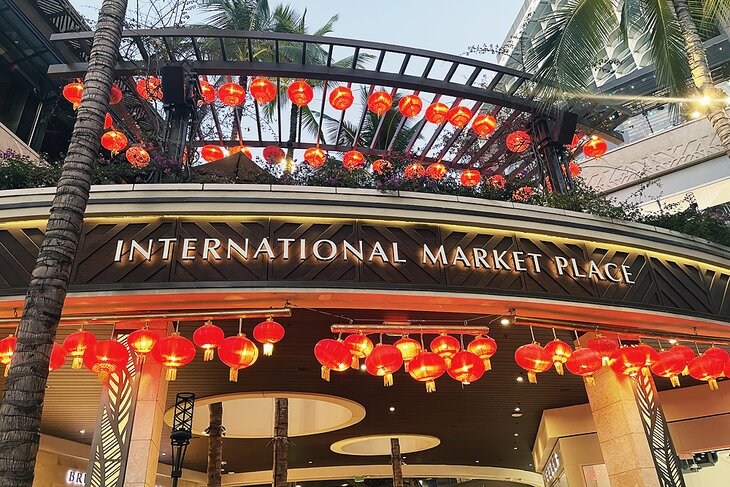
The International Market Place is a long-established collection of open-air shops in Waikiki, which take shelter under huge banyan trees strung with twinkly lights at night. Retail shops include internationally-renowned names like Saks Fifth Avenue, Burberry, and Swarovski, as well as locally famed products like Kona Coffee.
Even if you aren't in the mood for shopping, this is a lovely area for a stroll and to people-watch, landscaped with tropical plants accented by water features.
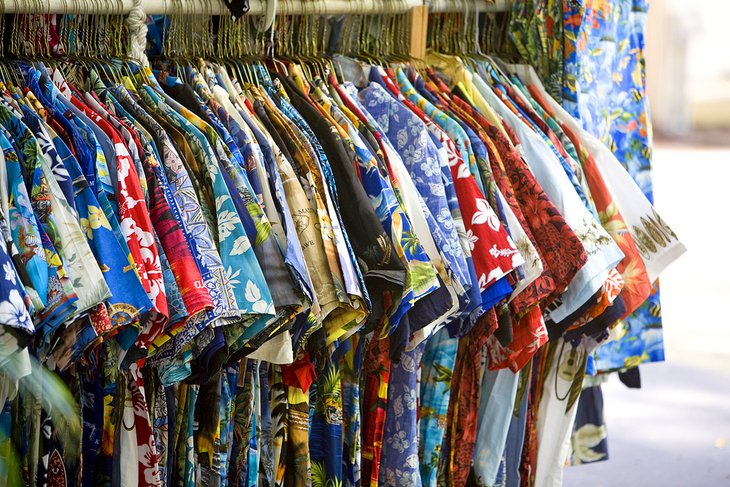
This is also where you can find nearly any type of food you are craving, with a huge selection of both quick food and full-service restaurants, which represent everything from Asian cuisine to Tex-Mex. The International Market Place also hosts a wide variety of events and activities, including food festivals, concerts, Lei-making classes, and more. This can be a fun thing to do at night in Waikiki.
Address: 2330 Kalakaua Avenue, Waikiki, Hawaii
Royal Hawaiian Shopping Center
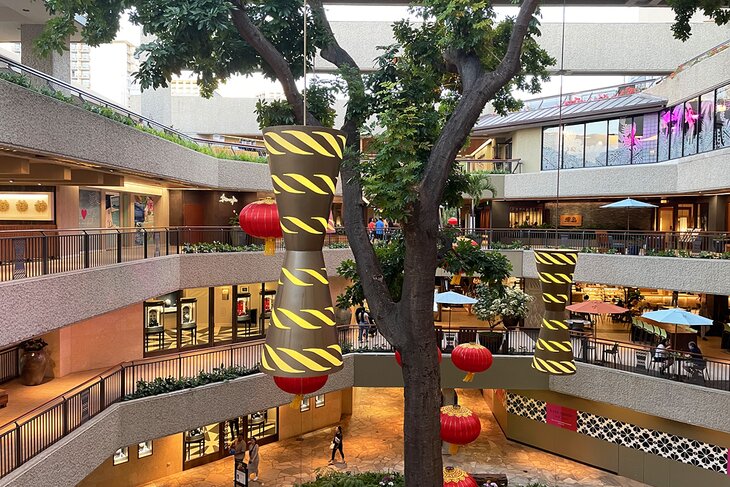
When you think about it, it's pretty amazing that Waikiki exists as a thriving metropolis on a small sliver of beach on a tiny island in the middle of the Pacific Ocean. This blip on the map is loaded with brand-name stores and designer labels, most of which can be found within the Royal Hawaiian Shopping Center.
Along Kalakaua Avenue, the Royal Hawaiian Shopping Center is an ultra-modern, luxury shopping complex with stores that run the gamut from watches and jewelry to boutiques, designer clothing, and restaurants.
Some of the best Waikiki restaurants and eateries are located within the shopping center, too. At any time of day, you'll find people snacking on fresh poke bowls in the food court, or stealing away into the higher-end dining rooms for excellent dinners.
More than just a shopping complex, however, the Royal Hawaiian Center has a lot of free things to do — which can be more than welcome in an expensive destination like Honolulu. Kumu (teachers) conduct hula lessons, as well as ukulele classes and instruction in lauhala weaving and lei making.
There are also regular hula shows, which feature traditional dancers in full costume, as well as an explanation of the art form's history and significance in Hawaiian culture. The center also provides live entertainment in the evening and frequent musical events featuring both traditional and contemporary Hawaiian music.
Address: 2201 Kalakaua Avenue, Honolulu, Hawaii
US Army Museum of Hawaii
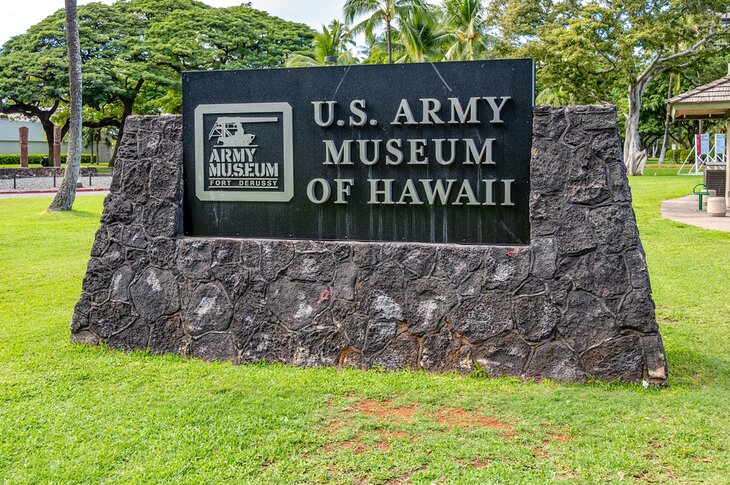
Among the exhibits in this small military museum are weapons from the time of the Hawaiian wars in the 18th century to the Second World War and the Vietnam War. Also on display are American soldiers' uniforms from the last 200 years, as well as enemy uniforms.
Most interest is doubtless aroused by the old Hawaiian weapons studded with sharks' teeth. These were used in battles between former Hawaiian tribes. The museum also features temporary exhibits. The collection is located in a 1909 building originally built to defend Honolulu and Pearl Harbor.
Address: 2131 Kalia Rd, Honolulu, Hawaii
Shangri La
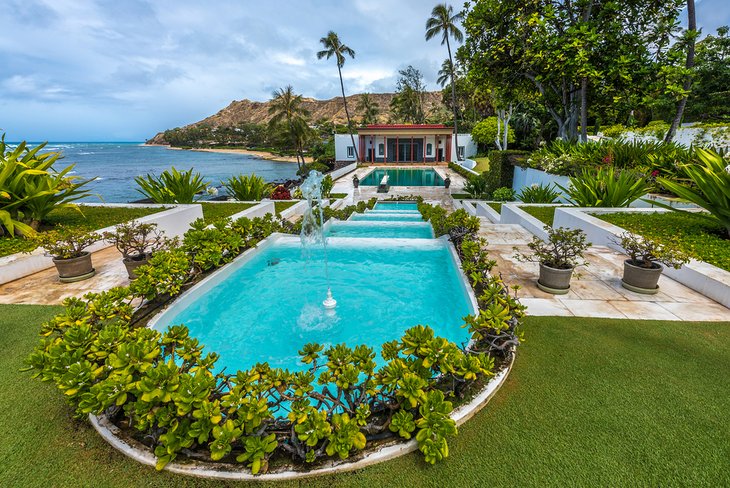
The collection found at Shangri La is an unexpected one given its setting on a Pacific Island, reflecting Doris Duke's love for both the island and Islamic culture. Shangri La, built as a vacation home to Doris and her husband, is now home to the Doris Duke Foundation for Islamic Art. The collections include approximately 2,500 items that represent some of the best creative work from the Middle East, Moorish Spain, India, and Asia.
In addition to decorative arts made of glass, ceramics, textiles, and other media, several of the museum's best examples are in its architecture. Commissioned by Doris in the 1930s, when she had the house built, several large installations by Moroccan, Indian, and Iranian artists were incorporated into the construction, giving it a truly unique ambiance.
The museum is operated by the Honolulu Museum of Art, which is located nearby in downtown Honolulu. It features permanent collections and visiting exhibits that showcase not only Polynesian art but works from around the world, focusing on Asian art. Collections also include works by Monet and Van Gogh, as well as artifacts from ancient Egypt, Rome, and Greece.
Address: 4055 Papu Circle, Honolulu, Hawaii
See the Kūhiō Beach Hula Show
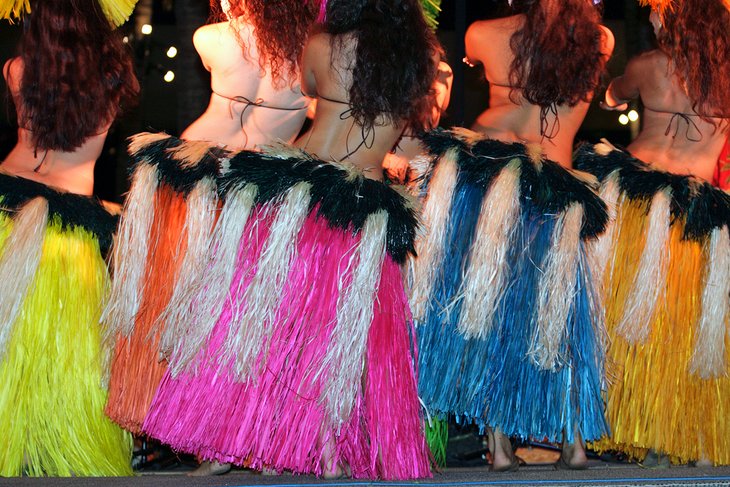
Several evenings per week on Kūhiō Beach, visitors can watch a free hour-long traditional hula dance performed on an authentic hula mound, or pa hula. The ceremony begins with the sound of a conch shell horn and then the lighting of torches, and features local dancers. The beach is conveniently located just off Kalakaua Avenue near the Honolulu Zoo.
On the other side of the island, a little over a one-hour drive from Waikiki, the Polynesian Cultural Center is another excellent spot to see traditional dance and customs in action. It is a living history museum, with six villages, each representing the culture of a Polynesian island, including Hawaii, Tahiti, Samoa, Fiji, Tonga, and Aotearoa (Maori for New Zealand). Visitors can enjoy hands-on activities within the center, as well as watch traditional dance and participate in an authentic luau.
Visit Iolani Palace
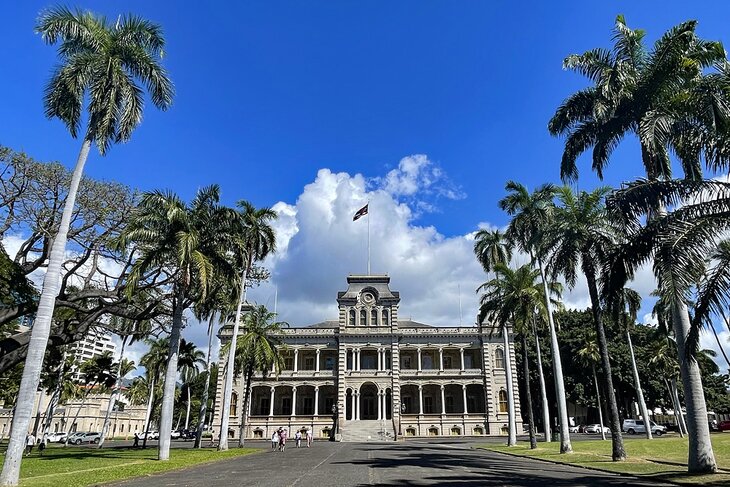
Waikiki is packed with history. In fact, Waikiki Beach was the spot where royal Hawaiians would welcome their visitors. You can explore the depths of Hawaiian history in Waikiki with a visit to Iolani Palace in Honolulu.
The land around Iolani Palace is steeped in Hawaiian history. King Kamehameha III built his official residence in 1845 on the grounds here, which served five Hawaiian kings until it was leveled in 1874. It was replaced with Iolani Palace in 1879, which became the home of the Hawaiian monarchs.
Today the palace's first and second floors have been restored and are open for guided tours. On the first floor, visitors will find the Grand Hall, State Dining Room, Blue Room, and Throne Room. The second floor has the private suites of the monarchs, including the room where Queen Liliuokalani was held imprisoned for eight months after her government was overthrown.
Address: 364 S King Street, Honolulu, Hawaii
Map of Tourist Attractions & Things to Do in Waikiki
More Related Articles on PlanetWare.com
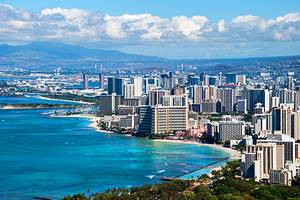
Exploring Honolulu: Tourists who are enjoying a vacation at one of Honolulu's top resorts will not want to miss out on the opportunity to explore the city and the surrounding area. Among Honolulu's top tourist attractions are several excellent museums, and natural sites like Hanauma Bay Nature Preserve and Diamond Head State Monument. The most visited place, however, is Pearl Harbor. The complex is home to the USS Arizona Memorial, an excellent visitor center, and several other historic attractions that commemorate those who lost their lives in the 1941 attack.
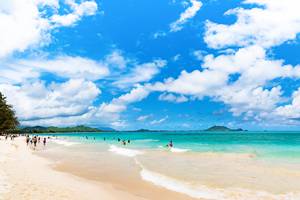
Beautiful Oahu: Because of the area's many things to do, visitors often choose to stay in Honolulu, but the Island of Oahu is small enough that tourists can stay in any one of the island's resorts and still visit Honolulu's attractions easily as a day trip. Surfers may want to consider staying on Oahu's north shore, where the waves are particularly gnarly. Couples might want to savor each evening's unforgettable sunset over the Pacific from the western shore, and families might be looking for a less crowded option among Oahu's most popular beaches.
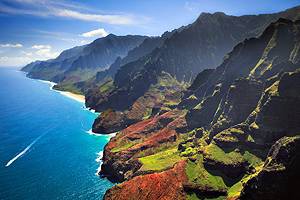
Island Hopping: Tourists with enough time will want to explore beyond Oahu and visit more of Hawaii's most visited tourist attractions. To the east, a wide variety of beaches and beautiful scenery await visitors to Maui, a popular place for surfing, swimming, and snorkeling. If you want to see an active volcano, look no further than the Big Island, home to Mauna Loa in Volcanoes National Park. West of Oahu sits Kauai, home to a variety of natural attractions and things to do, including the impressive Waimea Canyon and the iconic Na Pali cliffs.
